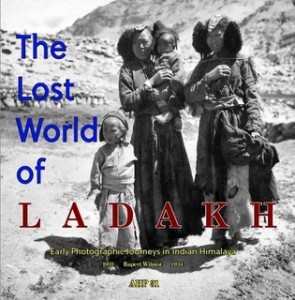Posted: August 9th, 2014 | 3 Comments »
Amazingly Shanghai is still to be the site for the 2015 World Congress on Art Deco – this seems about as sensible a decision as making Afghanistan the site of the 2015 World Congress of Women’s Rights and Religious Tolerance. The more Shanghai destroys, the more it is rewarded – if the World Congress (whoever they are?) thought that awarding Shanghai a conference would save anything then it appears they are much mistaken. A sick joke perhaps? Now word reaches me that the lovely art-deco Metropole Hotel in Shanghai is about to get a “refurbishment”/”make over” – I think we can all agree that this will translate as a “trashing”. So, if you can – pop along and see the American Bar and lobby in its full art-nouveau glory before it’s refurbished out of existence. Shanghai’s original Metropole Hotel, built towards the end of the nineteenth century, was opposite the old race course on Bubbling Well Road (Nanjing Road West). That’s long gone and not a trace remains. The current Metropole was built on the junctions of Honan Road (Henan Road Middle) and Foochow Road (Fuzhou Road) in 1930 (the first picture below shows the building around the time of final completion) with the (still in existence) Hamilton House attached. There was also a Metropole Theatre not too far away on Thibet Road (Xizhang Road). The American Bar as you can see below is a key part of the lobby with the wonderful staircase – just what will survive the refurbishment will be seen but previous hotel make overs in Shanghai suggest not a lot. The American Bar was a hang out for many Americans, and others, in pre-war Shanghai – the American Club (on Foochow Road) as well as the American Chamber of Commerce (moved around but in Hamilton House for a long time), the American Court for China and the various administrative centres of the International Settlement were all close by.





Posted: August 6th, 2014 | 1 Comment »
I’m going to assume that most China Rhyming readers are aware, at least partially, of Julian Bell and his time in China in the 1930s. Born in 1908, the son of the artists Clive and Vanessa Bell (Virginia Woolf’s sister), after Cambridge Bell went to China in 1935 to teach English at Wuhan University. There of course he had a notorious affair that scandalised the college, led to his firing, and has since been novelised rather controversially by Hong Ying in her book K: The Art of Love (which I rather liked, but lots of people don’t and the heirs of Ling Shuhua certainly did not). However, the Bloomsbury Group/Crescent Moon Society crossovers are fascinating. After China Bell went as a volunteer ambulance driver to aid the Spanish Republic and was killed, after a just a month, at the Battle of Brunete, aged just 29.
But where did Bell’s interest in China come from? It’s often assumed it was a combination of the European depression, wanting to escape the claustrophobic confines of his parents’ reputations (and their rather tangled love affairs) and the Bloomsbury set, with a bit of Left wing odyssey, general curiosity and wanderlust thrown in. However, perhaps China, or an idea of China, was inculcated in Bell far earlier.
A recent visit to Charleston, the boyhood home of Bell in Sussex and the home of Vanessa Bell and Duncan Grant (and various others over the times they all loved there as the Bloomsbury Group in the country) offers a few clues. A major one is that the house is largely painted with murals and decals by Vanessa Bell and Duncan Grant. Bloomsbury of course liked it Chinoiserie, and Charleston has any number of blue and white plates, Chinese sculptures and Chinesey bits and bobs. More interestingly perhaps, on one door panel is painted a Chinese acrobat, by Duncan Grant. This idea would later be the subject of a more formal painting by the artist….See below first the door panel at Charleston and then the later drawing in pencil, watercolour and gouache on buff paper. Perhaps it was this Chinese acrobat Bell saw as a child every day on the door of the living room at Charleston that partly led to his trip to China in 1935?

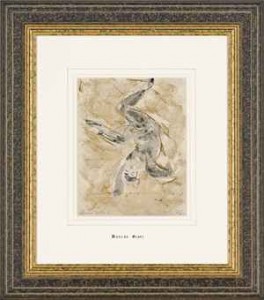 signed with initials ´DG´ (lower right) and inscribed ´Chinese Theatre Co.´ (lower left)
signed with initials ´DG´ (lower right) and inscribed ´Chinese Theatre Co.´ (lower left)
Posted: August 5th, 2014 | No Comments »
A couple of summer reads I thought regular China Rhyming viewers might find interesting….
Karolin Kan in That’s Shanghai on the (mis) fortunes of KMT Army vets from WW2 who live in the PRC, a land that can’t quite deal with who actually fought the Japanese….Soldiers of Misfortune…..;
The WSJ’s China Real Time blog has a Q&A with CASS Japan Specialist Ma Yong on the First Sino-Japanese War…Still Testy After 120 Years;
And, the Los Angeles Review of Books China blog has a review of the first four books published in the Penguin China World War One series….China’s Forgotten World War One
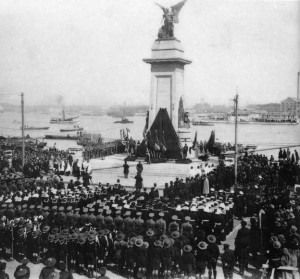 The dedication of the WWI memorial on the Shanghai Bund, in 1924
The dedication of the WWI memorial on the Shanghai Bund, in 1924
Posted: August 5th, 2014 | No Comments »
The Asia’s Transformations series is a flagship series for Routledge Asian Studies, with around 100 titles exploring the political, social, economic and cultural consequences of Asia’s twentieth and twenty-first century transformations. Series editor Mark Selden has chosen a selection of influential titles from the series and for this month only Routledge are offering these as free to view to online!

About the Series
The Asia’s Transformations series emphasizes the tumultuous interplay of local, national, regional and global forces as Asia bids to become the hub of the world economy. While focusing on the contemporary, it also looks back to analyze the antecedents of Asia’s contested rise. Asia’s Transformations aims to address the needs of students and teachers with a diverse selection of books offering a comprehensive view of Asia in the 21st century.
The following titles are available to read online for free, in their entirety, until 31st August 2014. These titles have been selected by series editor Mark Selden to offer a taste of the diverse selection of books offered through the series – simply click on the links below for each book, hit the blue “View Inside this Book” button and start reading!
You can view the entire series in our online catalog here – and we are pleased to offer a special 20% discount off all books in the series until the end of July for all orders through www.routledge.com. Simply enter the code ASIAST2014 at the checkout.
Free to View Online – Simply click the link on the books below and hit the blue “View inside this Book” button
The Resurgence of East Asia: 500, 150 and 50 Year Perspectives
Edited by Giovanni Arrighi, Takeshi Hamashita and Mark Selden
The East Asian expansion since the 1960s stands out as a global power shift with few historical precedents. The Resurgence of East Asia examines the rise of the region as one of the world’s economic power centres from three temporal perspectives: 500 years, 150 years and 50 years, each denoting an epoch in regional and world history and providing a vantage point against which to assess contemporary developments.
Korean Society
Civil Society, Democracy and the State, 2nd Edition
Edited by Charles K. Armstrong
While most analyses of Korean politics have looked to elites to explain political change, this revised edition of Korean Society examines the role of ordinary people in this dramatic transformation. Taking the innovative theme of ‘civil society’ – voluntary organizations outside the role of the state which have participated in the process of political and social democratization – the essays collected here examine Korea as one of the most dramatic cases in the world of ordinary citizens participating in the transformation of politics.
Chinese Politics
State, Society and the Market
Edited by Peter Gries and Stanley Rosen
Written by a team of leading China scholars this text interrogates the dynamics of state power and legitimation in 21st Century China.
Japan’s Quiet Transformation
Social Change and Civil Society in the 21st Century
Jeff Kingston
‘Kingston has provided a well researched and also readable synthesis of developments in Japan since the collapse of the bubble economy in 1989….The fact that Kingston happens to be a rare example of an academician who can combine sound analysis with entertaining prose makes it possible to recommend this book to just about anyone interested in contemporary Japan.’ – International Herald Tribune
Popular Culture and the State in East and Southeast Asia
Edited by Nissim Otmazgin and Eyal Ben-Ari
This volume examines the relations between popular culture production and export and the state in East and Southeast Asia including the urban centres and middle-classes of Taiwan, South Korea, Japan, Singapore, Indonesia, Malaysia, China, Thailand, and the Philippines.
Chinese Society
Change, Conflict and Resistance, 3rd Edition
Edited by Elizabeth J. Perry and Mark Selden
‘This first rate collection will be indispensable reading for Scholars of Chinese society. Each of the book’s uniformly excellent well-written and substantive chapters open by providing enough historical background onits specific topic to make it comprehensible enough to advanced undergraduates as well as the general informed reader.’ – The China Journal
Japan’s Comfort Women
Sexual Slavery and Prostitution During World War II and the U.S. Occupation
Yuki Tanaka
Japan’s Comfort Women tells the harrowing story of the “comfort women” who were forced to enter prostitution to serve the Japanese Imperial army, often living in appalling conditions of sexual slavery. Using a wide range of primary sources, the author for the first time links military controlled prostitution with enforced prostitution.
Global Shanghai: 1850-2010
A History in Fragments
Jeffrey N. Wasserstrom
‘Adopting a global rather than Eurocentric perspective, Wasserstrom has produced a fascinating, well-researched and empirically grounded study that sheds much needed light on Shanghai’s emergence, and re-emergence, as a cosmopolitan city of global importance. Highly Recommended.’ – History News Network
Technology, Gender and History in Imperial China
Great Transformations Reconsidered
Francesca Bray
In this book, Francesca Bray explores subjects such as technology and ethics, technology and gendered subjectivities (both female and male), and technology and statecraft to illuminate how material settings and practices shaped topographies of everyday experience and ideologies of government, techniques of the self and technologies of the subject.
Mapping China and Managing the World
Culture, Cartography and Cosmology in Late Imperial Times
Richard J. Smith
This book brings together a selection of essays by Richard J. Smith, one of the foremost scholars of Chinese intellectual and cultural history. Mapping China and Managing the World focuses on Chinese constructions of order and examines the most important ways in which elites in late imperial China sought to order their vast and variegated world, and will be welcomed by Chinese and East Asian historians, as well as those interested more broadly in the culture of China and East Asia.
Decoding Subaltern Politics
Ideology, Disguise, and Resistance in Agrarian Politics
James C. Scott
This book brings together James C. Scott’s most important work on peasant religion and ideology; everyday forms of peasant resistance; and state technologies of personal identification. In a collection of interrelated essays Scott introduces the major concepts that lie at the core of his work and illustrates, through ethnographic and historical work how they can be understood through practical examples.
Opium, Empire and the Global Political Economy
A Study of the Asian Opium Trade 1750-1950
Carl Trocki
‘…a very important argument with implications beyond the social history of drugs, into the broader history of the founding of empire.‘ – Professor Nigel South, University of Essex
Posted: August 4th, 2014 | 1 Comment »
A slight deviation as it’s the centenary of the First World War I ( Britain went to war on August 4 1914). thought I’d just offer up a list of books that deal with the home front – which interests me a bit more than the battlefields. Compared to World War Two home front literature, reminisces and novels are harder to come by, but the following were illuminating. Fear not – normal China resumed tomorrow…

Guignol’s Band – Louis-Ferdinand Celine – Celine’s third novel, first published in 1944 but dealing with events taking place during the First World War, Guignol’s Band follows the narrator’s meanderings through London after he has been demobilized due to a war injury. The result is a frank, uncompromising, yet grotesquely funny portrayal of the English capital’s seedy underworld, peopled by prostitutes, pimps and schemers.

The Pretty Lady – Arnold Bennett – ‘The Pretty Lady’ is considered to be one of Bennett’s most revealing and under-rated works. It is the story of a French prostitute, Christine, who has escaped from wartime Ostend, and set herself up in business in London. Though a refugee, she demands no pity; she is self-sufficient, practical and realistic. Christine is not a harpy preying on innocent soldiers, but a canny businesswoman, doing the best she can with the opportunities life has given her. Her main relationship is with G.J. Hoape, a wealthy man above the military age. Bennett in this novel presents a disturbing image of wartime society, fragmented, uneasy and divided. There are references to industrial unrest and to social injustices, and hints that the British press is less than frank about the war. A discussion on the controversies around the book here.

The Emperor’s Tomb – Joseph Roth – The Emperor’s Tomb is a magically evocative, haunting elegy to the vanished world of the Austro-Hungarian Empire, and to the passing of time and the loss of youth and friends. Prophetic and regretful, intuitive and exact, Roth’s acclaimed novel is the tale of one man’s struggle to come to terms with the uncongenial society of post-First World War Vienna and the first intimations of Nazi barbarities.

Zeppelin Nights – London in tjhe First World War – Jerry White – 11pm, Tuesday 4 August 1914: with the declaration of war London becomes one of the greatest killing machines in human history. Hundreds of thousands of soldiers pass through the capital on their way to the front; wounded men are brought back to be treated in London’s hospitals; and millions of shells are produced in its factories. The war changes London life for ever. Women escape the drudgery of domestic service to work as munitionettes. Full employment puts money into the pockets of the London poor for the first time. Self-appointed moral guardians seize the chance to clamp down on drink, frivolous entertainment and licentious behaviour. As the war drags on, gloom often descends on the capital. And at night London is plunged into darkness for fear of German bombers and Zeppelins that continue to raid the city. Yet despite daily casualty lists, food shortages and enemy bombing, Londoners are determined to get on with their lives and flock to cinemas and theatres, dance halls and shebeens, firmly resolved not to let Germans or puritans spoil their enjoyment. Peopled with patriots and pacifists, clergymen and thieves, bluestockings and prostitutes, Jerry White’s magnificent panorama reveals a struggling yet flourishing city.
Posted: August 3rd, 2014 | No Comments »
Fire wrought some terrible catastrophes last week – miles apart. Eastbourne Pier, a marvellous Victorian pier, was gutted by fire and is a tragedy to those of us who love piers. Also, and a bit more relevant to this blog, the Jiangbei Sacred Heart Church in Ningbo. Sadly the 142 year old church appears to be pretty much gutted with the interior completely lost. However, the impressive bell tower and spire as well as the church’s outbuildings have remained intact and the tower appears to still be solid and salvageable.
The Catholic Scared Heart (Sacre Coeur) Church was built in 1872 by French missionaries. As well as a Christian tradition it was used as a base by communists so had a level of protection. Like so many churches and religious institutions across China it was mindlessly damaged during the Cultural Revolution. The church was returned to the Catholic community in 1980.
Quite how the fire started in Ningbo remains a mystery – how the fire started in Eastbourne has been established – sparks and electrical problems in the disgustuing games machine arcade that was housed in what (and you could still see the structure’s interior clearly if you visited) had once been the lovely theatre/dance hall portion of the pier. Art, culture and dancing sadly gave way to slot machines, video games and grab a pack of fags machines along with a filthy burger bar!

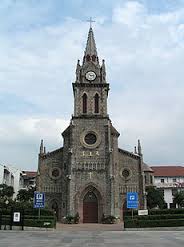 Sacred Heart Church prior to the fire
Sacred Heart Church prior to the fire
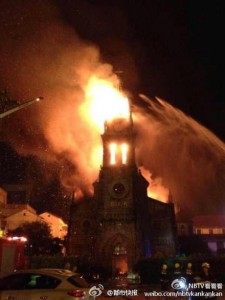 on fire
on fire
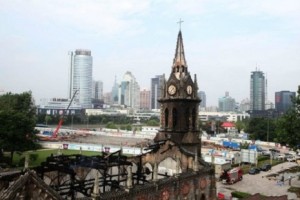 Sadly gutted
Sadly gutted
Posted: August 2nd, 2014 | 1 Comment »
Charlie Eisenberg was a US Navy sailor who passed through Shanghai in the early 1920s, liked it, stayed and opened a bar (which I’m afraid I don’t know the name or location of?? Some have suggested the Bund, but I suspect that’s not quite right. Any takers on that one?). Later, around 1927, Eisenberg, who’d taken on the moniker Shanghai Red, returned to San Pedro and opened a bar on the town’s rather insalubrious Beacon Street called Shanghai Red. He was an almost perfect bar owner for the tough, sailor ridden strip and was quite capable of throwing out anyone who caused trouble – as he is in this photo….Shanghai’s bar business required a certain toughness, San Pedro no less it seems…



















